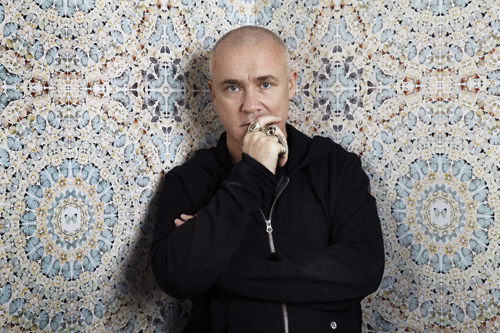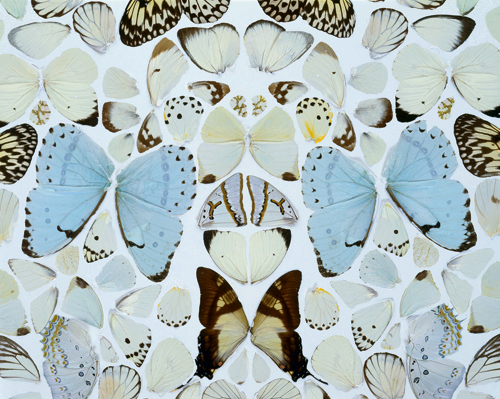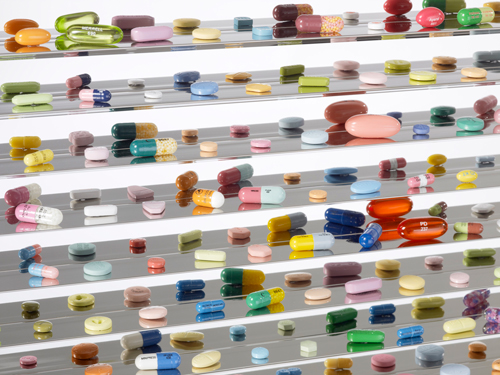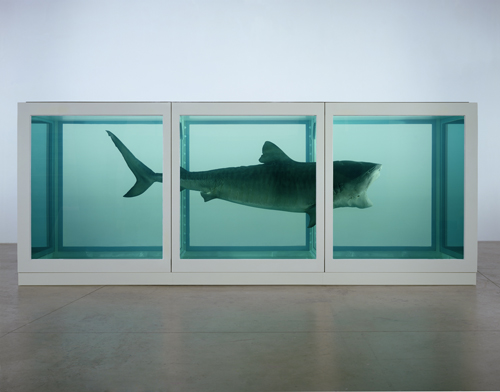Damien Hirst
Tate Modern, London
4 April–9 September 2012
by CELIA WHITE

Portrait of Damien Hirst. Photograph: Billie Scheepers. © Damien Hirst and Science Ltd. All rights reserved, DACS 2012.
In fact, it’s up to us to fit our ideas and preconceptions around this new definition: to accommodate the notion that as well as a creator, an artist can be a curator, collector, patron, entrepreneur, PR expert, salesman and critic. Testament to Hirst’s fusion of these roles is his curation of the landmark Freeze exhibition of 1988, the show that first waved the YBAs under the nose of Charles Saatchi; his outsourcing of parts of his practice to a colony of studio assistants; his growing collection of contemporary art, which he exhibited in a self-curated show at the Serpentine Gallery in 2007; his unprecedented 2008 sale at Sotheby’s, in which he bypassed the galleries and sold straight at auction, making an unfathomably large £111 million in one evening; the live video feed to his studio1; his “takeover” of the Guardian arts pages in the opening weeks of the Tate show; and his recent Channel 4 interview with Noel Fielding, in which he sported a suspiciously down-to-earth attitude, a willingness not to take himself quite so seriously as almost everyone else seems to (Fielding included).2

Damien Hirst. Sympathy in White Major – Absolution II, 2006 (detail). Butterflies and household gloss on canvas. © Damien Hirst and Science Ltd. All rights reserved. DACS 2012. Photograph: Prudence Cuming Associates.
The problem is that Hirst is the best, if not the only, true exemplar of this new form of artist, and it is this fact that makes the Tate show so fascinating. Hirst’s artistic practice can be mapped onto the most basic of business models: create a demand for something, and then supply that demand. Stimulate an appetite for dead animals in liquid, spotted canvases, piles of discarded cigarettes and (admittedly exploiting a pre-existing desire) diamond-laden objects, and people will flock to see your work. There’s a feeling from the outset of Tate’s show that Hirst has been its ultimate curator, and this makes for a visual and intellectual feast, if not a biased one.
Given this sense of the artist’s over-involvement in the show, and considering the furore over Hirst’s work since he rose to prominence in the late 1980s, Tate’s exhibition is a surprisingly subtle, almost empirical, presentation of Hirst’s oeuvre. Covering his 24-year career, it combines the two formats of retrospective and solo exhibition by tracking Hirst’s artistic development while also exploring the conceptual complexity and variety that characterises it. In doing so, it rejects the comfortable temporal separation that a retrospective offers, as well as its historiographical succinctness, in which the history of an artist is revealed in a series of tableaux in which the parts rely on and reflect the whole. Instead, Tate’s is a dangerously unfinished tale: animals in formaldehyde, butterflies hatching from canvases and row upon row of diamonds and pills imply that if anything goes, then anything could follow. Art is getting younger, its histories shorter and more consumable, its future less certain.

Damien Hirst. Lullaby, the Seasons, 2002 (detail). Glass, stainless steel, steel, aluminium, nickel, bismuth and cast resin, coloured plaster and painted pills with dry transfers. © Damien Hirst and Science Ltd. All rights reserved. DACS 2012. Photograph: Prudence Cuming Associates.
The exhibition’s first room, showing Hirst’s early work, is itself a potted history of the artist’s oeuvre. In Boxes (1988), the sprawling, brightly coloured cubes and rectangles that emanate from one corner of the space are a reminder of the artist’s struggle with the relationship between colour and form. Controlling colour, rather than “it controlling me”, became a preoccupation that was the basis for the spot paintings that Hirst continues to make today, and in this room the large-scale Spot Painting of 1986 reveals these preliminary battles with colour.3 Rather than the precise, deadpan circles that he painted from 1988 (and which, through clever curation, can be seen and compared with a glance into the show’s second room), the 1986 Spot Painting is crowded, dripping, almost slovenly. The colours are evenly distributed, but their circular containers jostle restlessly as if pushing to be elsewhere. Alongside these experiments sits a photograph of Hirst the student grinning next to a cadaver’s severed head, presaging Hirst’s long-time preoccupation with death, and the contrasting humour of What Goes Up Must Come Down (1994), a hairdryer keeping a ping-pong ball afloat in a enduring yet fragile and ultimately pointless act. The curators offer us the kernel of Hirst’s success: he covers all corners, bringing the painterly into confrontation with the sculptural, dwelling on the macabre while engaging in play.
In fact the artworks for which Hirst is best known, his animals suspended and preserved in formaldehyde, are those that make bedfellows of death and humour. This show includes the blockbuster pieces The Physical Impossibility of Death in the Mind of Someone Living (the shark in a tank of 1991) and Mother and Child Divided (originally 1993), a cow and a calf each cut into two, their insides laid bare. Seeing these works in the retrospective format deprives them of some hard-to-define element that they certainly held when first displayed two decades ago. Fear resulting from the shark’s apparent movement behind the warped glass; disgust and awe at the cows’ innards; deep morbidity at the pointlessness of their deaths – these feelings are now numbed. Rather than involuntary responses, they are faded cognitive pathways that need reconstructing as we try to remember why we were once so deeply alarmed and repulsed.

Damien Hirst. The Physical Impossibility of Death in the Mind of Someone Living, 1991. Glass, painted steel, silicone, monofilament, shark and formaldehyde solution. © Damien Hirst and Science Ltd. All rights reserved. DACS 2012. Photograph: Prudence Cuming Associates.
The diminishing of this once extreme reaction is ironic given that these artworks’ symbolism is rooted in the memento mori that have featured in art, usually in the form of a skull, throughout art’s history. Despite the enduring nature of our need to be reminded of death’s inevitability, regardless of social, intellectual and cultural changes across the centuries, Hirst’s versions of such memento mori fail to carry their message for more than 20 years. His more recent work addressing death does so far more powerfully. For the Love of God (2007), Hirst’s diamond-encrusted skull, is irrefutably stunning: its blinding brightness reiterates our wilful ignorance of death in a way that the entanked shark no longer can. Black Sun of 2004 likewise fuses aesthetic elements such as scale, colour and texture to provoke a confrontation with death. An enormous circular “painting” consisting of undulating clumps of dead flies’ bodies, and sporting at once a dessicated, dry matt look and a sickly shine, it’s a hell to the diamond skull’s dazzling white heaven.
It could be that the earlier works’ failure to resonate with contemporary audiences is due to our changing demands as visual consumers: since the early 1990s, our exposure to the dead and the disgusting has increased dramatically through the proliferation of new and high quality media, as has our appetite for it. As a result, Hirst’s pieces featuring what can only be termed “live death” – real creatures living, feeding, and expiring – are more compelling than his formaldehyde sculptures in the context of this show.
In A Thousand Years (1990), for instance, the stench of the rotting cow’s head as flies are born, feast on the head and are put to their electronic deaths is far from off-putting judging by the crowds lining the head’s steel-and-glass prison. Beyond this, and also looking on, is the tail-end of a queue of visitors, which starts two rooms away, leading to a space inhabited by live butterflies in a reconstruction of Hirst’s 1991 work In and Out of Love. In this hot, bright environment, the beautiful but damned occupants with their disturbing flight paths perform the life cycle before us, for us, in the name of death’s spectacle. It’s also in the name of fine art: pupae are lodged in the walls’ white canvases and the juices that track the patterns of their births paint these canvases into existence. The creatures die on a high white table in the room’s centre, or attached to the clothing of a visitor only to fall unceremoniously to the floor in a future room of the show.
Butterflies appear again later in the exhibition, in a pair of epic paintings entitled Doorways to the Kingdom of Heaven (2007) and I Am Become Death, Shatterer of Worlds (2006). These resemble stained glass windows but are made up of hand painted motifs incorporating thousands of real butterfly carcasses. Stunning as these paintings are in their intricacy, however, the continual repetition of this and other visual motifs throughout the exhibition soon begins to compromise their impact. Cigarettes, for instance, appeared in the two rooms prior to In and Out of Love, burnt out in ashtrays dotted around the room; a mega-scale ashtray appears in a later room, likewise inexplicable in its message. Is Hirst trying to tell us that cigarettes kill? But medicines are also bad for us: this is the only advice we can glean from the aesthetically-muted full scale replica of a pharmacy that inhabits one room, and from the series of wall cabinets showing miniature pharmacies and pills lined row after row, repeating the obvious message that what appears to help can also harm. On the other hand, these motifs might recur simply as experiments with form and colour: Hirst, who used to smoke, has described the cigarette as a distinctly minimalist form4, and the glimmering replica pills displayed in mirrored cabinets in Lullaby, the Seasons (2002) offer a patchwork of colour in the hues of spring, summer, autumn and winter to powerful effect.
By reiterating the same themes in several formal manifestations, Hirst leaves his intentions open: does he reveal and criticise, or merely observe and faciliate, our fascination with death, the preservation of the dead, and the simultaneous preservation and destruction of ourselves until we’re dead? The penultimate room of the exhibition ties up these loose ends in a way that implies Hirst’s main concern is in actual fact the financial gain to be reaped from art that entertains these potentially abhorrent characteristics of human thought and behaviour. Lined with gold in every sense, this space is a shrine to Hirst’s phenomenal Sotheby’s sale in 2008, held a week prior to the crash of the global stock markets. Testament to this is the gold wallpaper, featuring visuals extracted from the sale’s catalogue. Each of the motifs that have recurred in the show thus far are represented here in gold – a sickly spot painting, much like the others but with a clashing gold background in place of white; butterflies floating on a gilt surface; a gold cabinet lined with smoked cigarettes and another, enormous in scale, playing host to rows of cubic zirconia “diamonds”.
If it reveals anything to us beyond Hirst’s love for money, this penultimate room indicates Hirst’s supreme skill at self-historicisation and thus of self-definition. By highlighting the significance of the Sotheby’s sale not only to his career but in relation to the peaks and troughs of the art market, the inclusion of such a room in the exhibition implies Hirst’s emphasis primarily on the “artist as salesman” role, valued well above the multifarious guises that contemporary artists can now inhabit.
Yet it’s the sudden sobriety of the exhibition’s final room that is the most telling by contrast to the lustrous abandon of the room before. A small space occupied only by an all-white spot painting and The Incomplete Truth (2008), a dove suspended in formaldehyde mid-flight, this room offers a curious end to the show, one that the curator claims symbolises the deliberate open-endedness of meaning in Hirst’s work as a whole and the unknown trajectories it will take in the future. But what this room fundamentally articulates, by contrast to the one before, is the enforced austerity that the art market and the wider economy have suffered following the years of untempered growth cut violently short in late September 2008. With Hirst’s prices still low and recovering far below the art market average5, the spirit of hope (or repentence) that the dove might symbolise is a little prayer for times like those back in the Sotheby’s sale room. And it’s a prayer that will be answered, if the popularity of this retrospective and its overstuffed gift shop are anything to go by.
References
2. Damien Hirst: The First Look, Channel 4, Monday 2 April 2012. See http://www.channel4.com/programmes/damien-hirst/4od#3312345
3. Damien Hirst, in Serota, Nicholas, ‘Nicholas Serota Interviews Damien Hirst’, Gallagher, A. (ed.), Damien Hirst (Tate Publishing, London; 2012), p. 92.
4. Discussing minimalism’s influence on his early work, Hirst stated: ‘Because I was smoking at the time, I remember looking at cigarettes as this minimal thing, and then thinking: “It’s the human element that screws up the minimal”’. Serota, ‘Nicholas Serota Interviews Damien Hirst’, p. 93.
5. See ‘Hirst opens at Tate as price of works falls’, Hannah Kuchler, Financial Times, 2 April 2012.